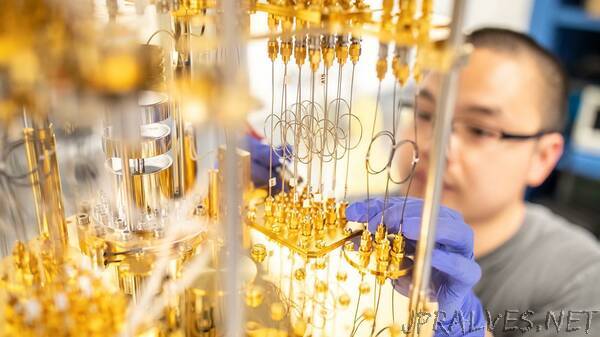
“Two studies show breakthroughs that could boost quantum technology
Scientists with the Institute for Molecular Engineering at the University of Chicago have made two breakthroughs in the quest to develop quantum technology. In one study, they entangled two quantum bits using sound for the first time; in another, they built the highest-quality long-range link between two qubits to date. The work brings us closer to harnessing quantum technology to make more powerful computers, ultra-sensitive sensors and secure transmissions.
“Both of these are transformative steps forward to quantum communications,” said co-author Andrew Cleland, the John A. MacLean Sr. Professor of Molecular Engineering at the IME and UChicago-affiliated Argonne National Laboratory. A leader in the development of superconducting quantum technology, he led the team that built the first “quantum machine,” demonstrating quantum performance in a mechanical resonator. “One of these experiments shows the precision and accuracy we can now achieve, and the other demonstrates a fundamental new ability for these qubits.”
Scientists and engineers see enormous potential in quantum technology, a field that uses the strange properties of the tiniest particles in nature to manipulate and transmit information. For example, under certain conditions, two particles can be “entangled”—their fates linked even when they’re not physically connected. Entangling particles allows you to do all kinds of cool things, like transmit information instantly to space or make unhackable networks.
“Both of these are transformative steps forward to quantum communications.”
—Prof. Andrew Cleland
—Prof. Andrew Cleland —Prof. Andrew Cleland
But the technology has a long way to go—literally: A huge challenge is sending quantum information any substantial amount of distance, along cables or fibers.
In a study published April 22 in Nature Physics, Cleland’s lab was able to build a system out of superconducting qubits that exchanged quantum information along a track nearly a meter long with extremely strong fidelity—with far higher performance has been previously demonstrated.
“The coupling was so strong that we can demonstrate a quantum phenomenon called ‘quantum ping-pong’—sending and then catching individual photons as they bounce back,” said Youpeng Zhong, a graduate student in Cleland’s group and the first author of the paper.
One of scientists’ breakthroughs was building the right device to send the signal. The key was shaping the pulses correctly—in an arc shape, like opening and closing a valve slowly, at just the right rate. This method of ‘throttling’ the quantum information helped them achieve such clarity that the system could pass a gold standard measurement of quantum entanglement, called a Bell test. This is a first for superconducting qubits, and it could be useful for building quantum computers as well as for quantum communications.
The other study, published April 26 in Science, shows a way to entangle two superconducting qubits using sound.
A challenge for scientists and engineers as they advance quantum technology is to be able to translate quantum signals from one medium to the other. For example, microwave light is perfect for carrying quantum signals around inside chips. “But you can’t send quantum information through the air in microwaves; the signal just gets swamped,” Cleland said.
The team built a system that could translate the qubits’ microwave language into acoustic sound and have it travel across the chip—using a receiver at the other end that could do the reverse translation.
It required some creative engineering: “Microwaves and acoustics are not friends, so we had to separate them onto two different materials and stack those on top of each other,” said Audrey Bienfait, a postdoctoral researcher and first author on the study. “But now that we’ve shown it is possible, it opens some interesting new possibilities for quantum sensors.”
Both studies made use of the Pritzker Nanofabrication Facility, a 10,000-square-foot clean room at the University of Chicago for groundbreaking nano research.”
